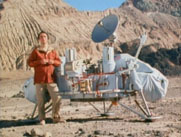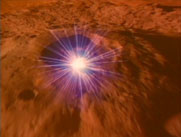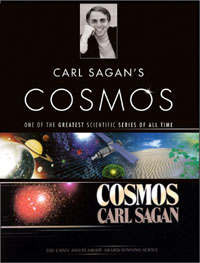|
Sagan begins with two key inspirations for the earlier prevailing beliefs
about Mars. The earliest section is all about the famous novel of
H.G. Wells: "The War of the Worlds", an exercise of nearly pure imagination
in contrasting then-current Human culture with something older that may have
evolved quite differently in a resource-drained Martian environment. It is
also noted how the later radio adaptation of this novel by Orson Wells
re-energized its hold over the American psyche.
Timed nearly in parallel are the thoughts championed by Percival Lowell.
These at least were fueled by some of the best observations by telescope
that anyone was able to achieve at the time, but with a bit of misinterpretation
in translating a colleague's observations from Italian to English,
and with a passion for speculation,
Mars was once again thought to be home to a civilization in present time,
as Lowell believed his observations might include evidence of their
construction activities.
According to Sagan, these two sources helped propel a multitude of other
imaginations concerning Mars. He himself got quite hooked on a series
of adventure fiction novels taking place on Mars. It is quite curious
to learn how casually many authors had their protagonists travel from
Earth to Mars, with no vehicle or mechanism more sophisticated than "wishing".
Most bizarre.
Celebrating Rocketry
"Cosmos" next delivers something quite unique, something perhaps more
applicable to all of space exploration, which could be dropped into any
episode. But the fact that Mars remained such a potent inspiration and
a target for our imagination and projections, this likely is really the
best place for it.
It is the very mechanical science of rocketry that takes center stage here,
and this episode gives significant focus to one of the key figures in its
invention: Robert Goddard. This episode's somewhat half-hearted attempts at
the usual historical recreation are upstaged by something better, because where
the invention of rocketry is concerned, we have plenty of archival photographs
and early film footage. We end up watching a lot of the real thing instead
in this episode, and the rocket mishaps, where Goddard didn't quite get
everything to work perfectly yet, are priceless, informative, educational,
and quite entertaining.
In preparation for understanding Mars, we first take a good look at the Earth
from space, to see exactly how close and detailed a photo needs to be
before signs of our civilization are detectable, much less obvious.
A fascinating sequence.
Mars Info-Dump
Then we go to Mars, for a lengthy full-on download of information. Many, many
maps and photos are shown, their rich details in sharp contrast to
Lowell's crude sketches that featured earlier in the program.
Sagan's inviting narration is loaded with information about Mars at this point,
and even subsequent viewings of the episode allow us to learn things
that we hadn't focused on before.
|
Another highlight at this point
has Sagan cruising over the surface, and in particular through Mariner Valley,
in his Ship of the Imagination. Perhaps it's worth noting the design of
the Ship here, because on my first viewing, this is probably the point
in the series when I first realised that the spikey star-shaped ball
I'd been seeing so often was actually meant to be the exterior of the ship.
This hadn't really been laid out with enough visual clarity in preceding episodes,
or in episode 6 which I'd skipped ahead to earlier as well. It's really
the act of putting Mariner Valley and the Martian surface behind it that
forced me to re-evaluate its size - now much smaller than a star - and notice
that it was actually following the same path as the visuals on Sagan's screen.
Very bizarre. Perhaps more carefully introducing it with some words
about the dandelion seed idea that it sprang from - ultimately
a very worthy piece of organic imagery - might have helped smooth it
into some kind of truce with the not-so-organic (or at all related)
look of the interior set.
Still, Sagan's imaginary ship remains a cool place from which to gather
and organize all the Mars information. Ultimately, we move from the data
gathered by Mariner towards an actual first landing on Mars - the essence
of the Viking program.
|
|
|
"Cosmos" then pulls off the signature sequence of the episode: simulating
the Viking landing on Mars by borrowing a demo mock-up from NASA, lowering
it into Death Valley, and intercutting Mars-tinted footage of its curious
operations with the actual photos that it returned from the Martian surface.
How's that for historical recreation? SPECTACULAR! It's particularly amusing
to see that the first thing Viking did after landing was to give the finger to
the Martian landscape (and by extension to any Martians who might happen
to be looking). How rude!
I guess we Humans have something to learn yet about interplanetary etiquette.
Viking's efforts to analyze the soil, and look for signs of life within it,
then take center stage. Sagan recounts the results of 2 of the 3 life-searching
results, saying they were positive, but doesn't really say how or if the third
experiment gave significant reason to doubt that life was there. Hmmm.
Perhaps communication could have been improved there.
The later chemistry lab scene actually inadvertently demonstrates
the grand failing of western medicine - throwing chemicals randomly
into a pot or patient, and just hoping that a healthy organism emerges!
Sagan's ridiculing of certain expectations here is worthwhile.
At this point, the show coasts into then-future speculation, which may
tempt us to look at it as outdated. Sagan emphasizes the need for mobile
robotic explorers to carry the scientific baton for investigating Mars,
while we see a very tall and awkward prototype lurching around the desert.
Thank goodness circuit miniaturization made possible the much more elegant
and compact rovers that we did eventually send to Mars since Cosmos was made,
and whose excellent data we have enjoyed since.
But Sagan's story takes a sad turn here, as the tragic story of his colleague
Wolf Vishniac exemplifies the struggle against cutbacks to the government-funded
NASA programs such as Mars exploration. Vishniac's proposed experiment could
have greatly helped solve the riddle of Martian soil, but didn't make it onto
the spaceship for budgetary reasons. Perhaps this coloured Sagan's perception
of public attitude towards Mars; perhaps he also believed people were profoundly
disappointed to discover that there were no thriving civilizations currently
to be found on the planet.
Or, perhaps Vishniac's experiments were axed because the results would have
revealed things that the powers that be would not have wanted revealed.
Both Vishniac's ultimate fate, and the place in which he came to that fate,
raise significant suspicions in light of things beings learned and revealed today.
In the larger context of all that has happened since, with a second round
of robotic exploration of Mars and other solar system bodies, and now new,
more realistic plans for Human expeditions to Mars, I'm somehow not quite
convinced that there really were all that many "Blues" sung for the Red Planet.
Perhaps it is because many of us are not quite as skeptical of all that has
so far been discovered there. On the whole, Sagan appears as open-minded as
any of us as to what the Pyramids of Elysium might represent, and that this
should ideally be a prime site for further exploration. Only in the
"Cosmos Update" recorded a decade later does he even mention the nearby
infamous "Face of Mars". Though he displays here his usual disbelief
that it amounts to any kind of intelligence, he does believe it's worth
a closer look.
For my part, I believe some form of bacterial or other simple life forms
will one day be confirmed on Mars, perhaps long after it has become a moot point,
but that won't be the truly big story. Remnants of past intelligent civilization,
buried under eons of sandstorms, would no doubt be a bigger deal, and this remains
my own personal suspicion.... my default assumption. I'm not sure additional
data, or more hard facts, could mean anything more to me than either, YES,
so they finally admit they found it, or okay, so they still haven't found anything YET.
So why don't we entertain a default assumption of prior Martian civilization
that nuked itself? Would we not approach the planet
more respectfully, and even archeologically inclined?
But more to the point, perhaps we should take a good sociological look at
ourselves. If any of us found remnants of a technological society on Mars
(or for that matter, somewhere here on Earth),
and we decided to try to reverse engineer and recreate or use any of the
technological discoveries made there, would we want to tell the rest of our
society all about it, or hoard the secrets of it for our own uses?
My belief continues to be that there are great archeological opportunities
on Mars that have yet to become practical or publicly revealed and acknowledged.
In that respect, Mars remains as it has always been in my mind, highly exciting.
To what degree might this episode have re-invigorated society's interest
and emotions towards Mars? Of that, I can only speculate, but I suspect
it certainly did its part then, as it still can today. It remains a darn
good chart of about 100 years of our history leading up to our first robotic
Mars landing, detailing our hopes and dreams and growing scientific understanding.
This episode has become one of the de-facto standards and cornerstones
upon which most other Mars documentaries build.
|














